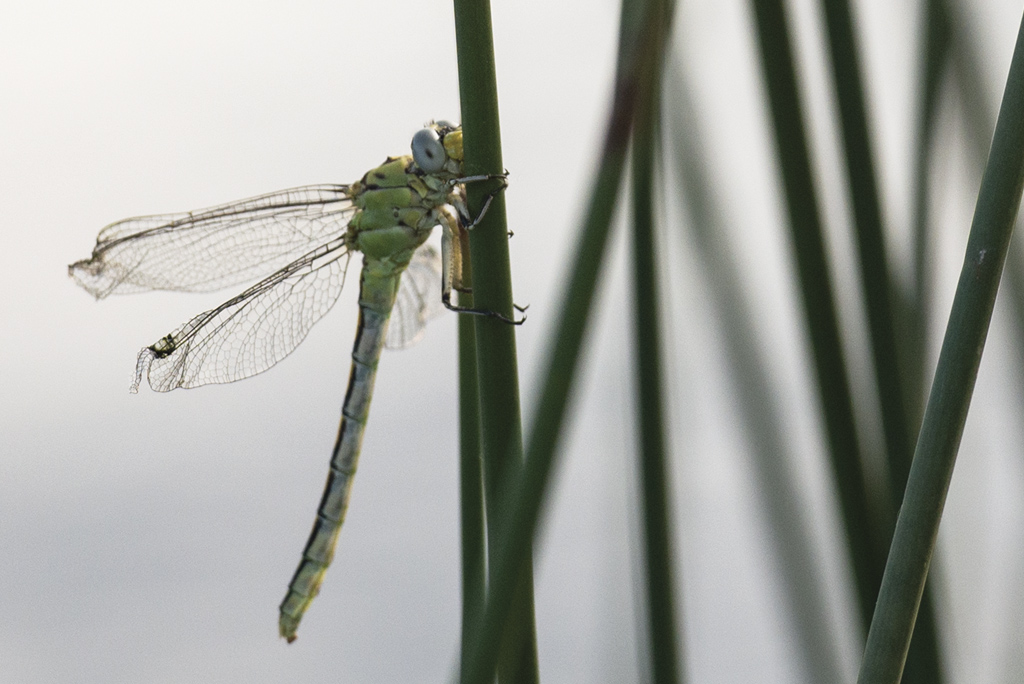Ephemeroptera. Trichoptera. Plecoptera. Chironimidae. If these words immediately dredge up distant memories of your high school Latin teacher and his/her weekly quizzing of your sum, es, est memorization skills, not to worry. You’re not being tested here. In fact, the above entomological nomenclature refers to the scientific orders of insects that serve an important purpose in the minds of flyfishing enthusiasts. These monikers signify fish food.
Trout, though lacking entirely in language skills, are fluent in the nature of the mayflies, caddisflies, stoneflies and midges referred to above. In fact, their intimate knowledge of these insects is critical in supporting their fishy lifecycles. The language of fish food might not be familiar to you, but it most certainly is to trout as it has been long before the days of the imperialist policies of the British and their ubiquitous distribution of Salmo trutta (read: brown trout) to the most remote corners of the globe.
Dumbed down, I do this for my own benefit; trout like bugs. They need bugs. Insects are a central focus of their feeding behavior in addition to many other desired food sources, including freshwater shrimp, terrestrials, leeches, snails, fish eggs and a wide variety of other fish. With this in mind, let’s take a quick look at four of the most common examples of insect-specific trout food to identify each and accurately choose the right imitation fly pattern to tie to the end of your line.
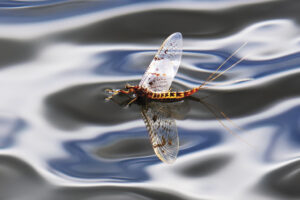
A mayfly sits on the water.
Mayflies
Mayflies, of the scientific order Ephemeroptera, are nature’s little ballerinas. Dainty and sublimely beautiful, they plie and pirouette above our serene Rocky Mountain waterways, appearing like colorful petite sailboats with their wings held high when they drift peacefully down the current lines and eddies of our local freestone rivers and spring creeks. That is, of course, until they are mercilessly devoured from below by voracious and bloodthirsty rainbow, brown, brook, cutthroat and, yes, tiger trout.
Mayflies make up a significant portion of a trout’s diet, and nowhere is this more notably true than on Silver Creek, a spring creek in the southern Wood River Valley near Picabo that is said to maintain the highest population of mayflies per river mile of any spring creek in North America. In parallel, Silver Creek also offers the highest trout population of any spring creek in North America per river mile.
The mayfly’s lifecycle begins with mating and the midair laying of eggs, which are dropped from the female to the surface of the water after fertilization by a similarly fluttering male. Within minutes of completing the annual ritual, both females and males alike, known as spinners in this stage of the life cycle, fall to the stream surface, lay out their wings and expire, often by the millions. The eggs sink to the streambed, where they mature for nearly a year as nymphs before swimming to the surface twelve months later as emergers and dry their wings as they momentarily float downstream as adults or duns and then fly away to rest, molt and return to the creek a day or two later to mate, die and initiate another chapter in the mayfly genealogy.
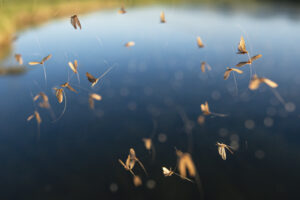
A swarm of caddisflies.
Caddisflies
Caddisflies of the order Trichoptera, more commonly referred to as moths by non-Latin-speaking non-anglers (read: normal people), are extremely robust-bodied insects and rich in protein. As such, they are a perfect dietary supplement for hungry trout, whether in their pupal stage (like the nymphal stage of mayflies), while emerging or as adults. Caddis are superb swimmers, and when they leave the subsurface to emerge, they do so with feist as they rush upward to avoid cruising trout on their way to the freedom of the skies above. There are few insects that elicit more aggressive trout strikes than caddis as fish recognize that the window to attack is limited, and they’d better hustle full-bore to intercept the highly valued mothy meal.
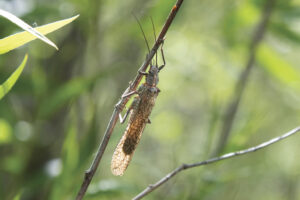
A stonefly crawls up a small stick.
Stoneflies
Of the Plecoptera order, perhaps none is more revered than Pteronarcys californica, the legendary Salmonfly. Stoneflies, in general, are badass bugs. They have the capacity to grow larger than the other insects that frequent a trout’s daily menu and will emerge with such prodigiousness that a serious hatch can effectively blot out the sun. Their four-winged torpedo-like bodies move with athleticism and speed around and over the boulders and bushes they inhabit during their molting behavior before their eventual mating cycle.
I recall driving along the Salmon River several years ago on a perfectly sunny day, only to notice a haze that occurred quickly and unexpectedly. Upon pulling over to investigate the dimming daylight, I realized that I had driven smackdab into a massive Salmonfly hatch. It was an eye-opening entomological experience.
Commonly, during stonefly season, most notably in early summer, trout gorge themselves so aggressively that their stomachs will bulge and overflow into their throats. And yet they will continue to feed. Some trout populations consume as much as 40% of their annual diet in a 10-day period, thanks to prolific stonefly hatches. Other stoneflies of note that occur throughout the year in central Idaho and the Northern Rockies include the Yellow Sally, Lime Sally, Little Black Stone, Large and Small Golden Stones and a variety of other sizes and colors that will test the lexicon of even the most proficient Latin-lover.
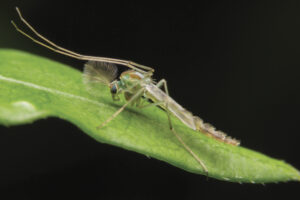
A chironimidae on a leaf.
Chironimidae
Chironomids, also commonly referred to as midges or snowflies, are most often present in our local river systems in the wintertime where they make up the bulk of entomologic intake for overwintering trout. These diminutive insects have black bodies and whitish wings, and, especially in February and March, they can result in spectacular dry fly activity on the Big Wood River, the Big Lost and Silver Creek. Due to lower angler numbers than the popular summer and fall seasons, this provides an excellent opportunity for those who value elbow room while experiencing our local world-class blue-ribbon trout waters. Dry fly patterns tied with CDC wings (cul-de-canard or duck anal feathers) are naturally buoyant dependable patterns, and subsurface options such as Zebra and Disco Midges make for excellent pupae imitations.
In sum (es, est), trout feed on the abovementioned food sources locally and globally, whether in Idaho, the chalk streams of the English countryside, the freestones of Chile and Argentina or the massive rivers of the eastern Himalayas. But, especially for the less-experienced angler, matching the hatch, meaning selecting an insect imitation that is essentially the same size, shape and color as the insects one witness flying, emerging or skittering around, will often lead to a productive and enjoyable day on the river. Even if the nomenclature of entomological fisheries biologies such as Paraleptophlebia, Callibaetis or Tricorythodes eludes you, ultimately, with sufficient determination and a handful of carefully chosen fly patterns, the trout at the end of your flyline will not.


